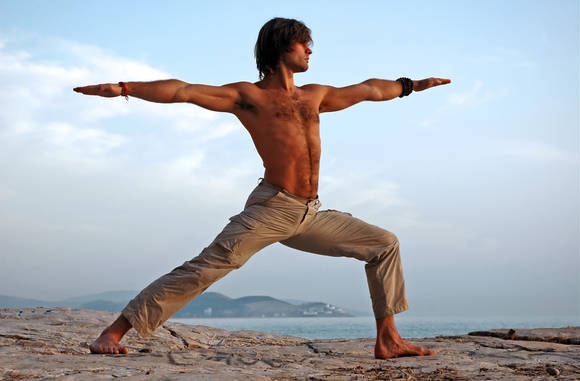Alignment is often overlooked by beginners, who often just want to get into the poses that will increase their strength and flexibility, or will cause them to break a sweat. But alignment is actually key to not some, but all yoga poses. The following poses described below will describe some key yoga exercises for beginners that will teach you to be conscious of proper alignment, so that you can be ready to properly get into the more difficult poses
Samasitihi Warrior 2 (Virabhadrasana 2)
Step your right foot out to a wide stance along the length of your mat. Angle your right foot in slightly so it faces the back of the mat, with your left foot pointing towards the front of the mat. Make sure that your right heel lines up with the arch of your left foot. Keeping your right leg active, meaning, lifting your kneecaps and engaging your thighs, while making sure that the edge of your right foot is planted firmly on the mat. Start bending your left leg so that the back of the knee forms a ninety-degree angle. Extend both arms out to the front and back, as if they were being pulled in opposite directions. Bring your gaze to the tip of your left middle finger. Make sure that your hipbones and shoulders are squared to the front, and that you are centered perfectly in the middle. Hold this pose for five breaths and switch to the other side.
Tree Pose (Vrksasana)
This standing externally rotated pose is great for strengthening the ankles, calves and core muscles, as you'll be engaging all of these to keep your balance. To get into this pose, press all four corners of your left foot onto the mat, especially the big toe. This will help you from wobbling as you stand on one foot. Now lift your right leg up to your ankle, shin or inner thigh – never on your knee as this can cause injury. Make sure that your hipbones are squared to the front, as if they were two headlights that need to be facing straight ahead. Now bring your hands together in front of your chest in a prayer position. Keep your core engaged and your spine long. Hold for about 8 breaths, release and switch to the other side.
Plank Pose (Ardha Chaturanga Dandasana)
From a tabletop position (on your hands and knees, shoulder and hip width apart), step your feet back and come into a straight line from your heels all the way to your shoulders. In terms of alignment, make sure that your shoulders are above your wrists, your hips the same level as your shoulders, and your feet hip-width apart. Also be conscious that your shoulders are not scrunched up, and are gently drawn away from your ears. Engage your core by drawing your navel towards your spine. This also strengthens the spine and back muscles in addition to toning your abdomen. Don't forget to keep your tailbone tucked towards your feet! This helps lengthen your lower back, avoiding compression and injury.
Perfecting these poses early on will stop you from forming bad yoga habits that become difficult to break the longer you continue practicing. Poses such as these that give equal importance to alignment and configuration are foundational to the more advanced poses that you will pick up along the way, so it's very important that you learn these basic beginner yoga exercises before you explore what else you are capable of as a yogi.


